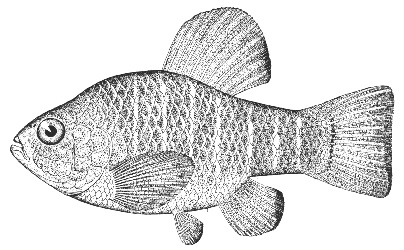Sheepshead minnow Cyprinodon variegatus Lacépède 1803
[Jordan and Evermann, 1896-1900, p. 671.]

Figure 78.—Sheepshead minnow (Cyprinodon variegatus), Maryland. From Jordan and Evermann. Drawing by A. H. Baldwin.
Description—
The sheepshead minnow is so deep bodied (its body is nearly half as deep as long, not counting the tail fin) that it is not apt to be mistaken for either of the mummichogs. And it is separated further from the mummichogs by its teeth, which are large, wedge-shaped and with tricuspid cutting edges, instead of small and pointed. It is a flat-sided little fish, with high arched back, small flat-topped head, small terminal mouth hardly gaping back to the forward edge of the eye, and it has the thick caudal peduncle characteristic of its family. Its tail is square (rounded in the mummichogs), and the fact that almost the whole of its dorsal fin is in front of the anal instead of over it affords another point of difference. The pectorals are large, reaching back past the base of the ventrals, which seem very small by contrast. Both its body and its head are covered with large rounded scales, largest on top of the head and on the cheeks, with one much larger than the others just above the pectoral fin. Young fish are proportionally more slender than old ones. The dorsal, ventral, and anal fins are higher in the males of this species than in the females, much as they [page 166] are in the mummichogs. The male is deeper bodied and the average size is larger than that of the female.
Color—
Out of breeding season both males and females are olive above (males rather darker and greener than females) with pale yellow or yellowish-white belly, dusky dorsal fin, and pale orange pectoral, ventral, and anal fins. The young of both sexes are irregularly barred with black transverse stripes, which persist through life in the female but become obscured in adult males. Females, furthermore, have a black spot on the rear corner of the dorsal fin, which is lacking in males, while the caudal fin of the male is marked by two black cross stripes, one at the base and the other at the margin. In breeding season the male assumes a brilliant coat, his upper parts turning to steel blue in front of the dorsal fin with a greenish luster behind it, while his belly brightens to a deep salmon, his ventrals and anal change to dusky margined with orange, and the front edge of his dorsal turns orange.
Size—
The largest specimens are about 3 inches long.
Habits—
The sheepshead minnow (like the common mummichog) is confined to the shallow waters of inlets, harbors, and the heads of bays, and salt marshes, often in brackish water. Its diet is partly vegetable, partly animal. It is very pugnacious, often killing fishes larger than itself, making repeated attacks with its sharp teeth and finally devouring its victim. Its breeding habits recall those of the mummichog (p. 163), the males fighting fiercely among themselves and clasping the females just forward of the tail with dorsal and anal fin, while the eggs and milt are extruded. Spawning takes place in shallow water from April to September, the eggs maturing a few at a time, so that any given female spawns at intervals throughout the season. The eggs sink and stick together in clumps by numerous threads. They are 1.2 to 1.4 mm. in diameter, with one large oil globule and many minute ones. Incubation occupies 5 or 6 days, and even at hatching the larvae (4 mm. long) show alternate light and dark crossbands. At a length of 9 mm. all the fins are formed, and at 12 mm. the fry show most of the characters of its parents.[2]
General range—
Atlantic coast of the United States, Cape Cod to Mexico, in brackish as well as in salt water.
Occurrence in the Gulf of Maine—
This fish, like many others, finds its northern limit at Cape Cod [page 167] and would not deserve mention here at all were it not recorded from the Cape by Storer. West and south of Cape Cod, however, as at Woods Hole, it is common enough in suitable situations. We have seined many of them with Fundulus at the head of Buzzards Bay.
[2] An account of courtship and spawning is given by Newman (Biol. Bull., vol. 12, No. 5, 1907, p. 336) and of development by Kuntz (Bull., U. S. Bur. of Fish., vol. 34, (1914) 1916, p. 409).